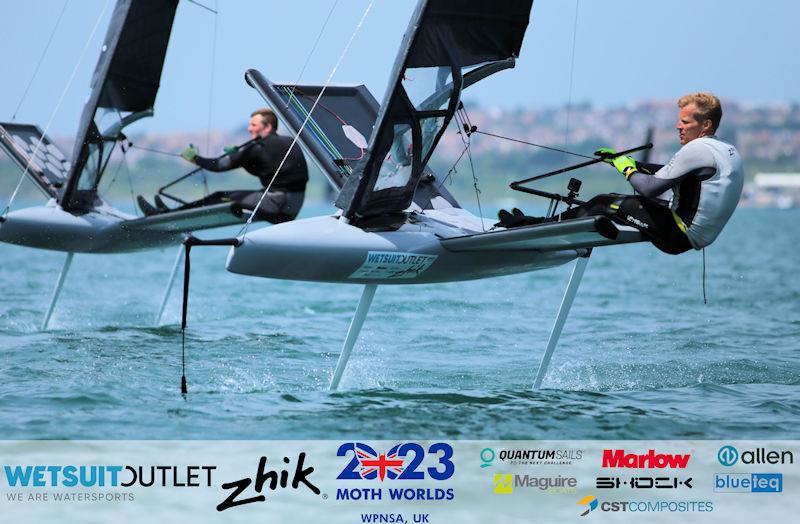
The never-ending quest for even more speed
by Mark Jardine 12 Jun 2023 13:00 PDT

Day 2 of the Wetsuit Outlet and Zhik International Moth UK Open Championship 2023 © Mark Jardine / IMCA UK
Development in the International Moth is relentless. The pursuit of more speed is the driving force of the designers, builders and sailors alike.
The downside of this is cost. The design, engineering, construction and materials are expensive, and the further the class develops, the finer the details get, and before long you hit the point where the best equipment becomes unaffordable to all but a few.
The foiling Moths have arguably been at this point for a decade, continually refining their sails, spars, hulls, rigging, control systems and foils. At the recently-held Annual General Meeting, a working group was set up to look at how to keep costs under control, without hindering the development ethos of the class.
The 18ft Skiffs, as well as many other development classes, have gone through similar stages in their evolution, adopting different approaches to strike the balance between staying on the cutting edge and retaining the numbers in their fleet. No single solution fits all circumstances, but each class needs to evaluate where they are, what is causing the rise in costs, and whether it should be reined in.
Somewhat unsurprisingly, foils are the big talking point at the moment. The underwater appendages which revolutionised the International Moth class are a far cry from the shapes they were when the boats first lifted out of the water over 20 years ago. They're thinner, smaller and the materials more esoteric. The general rule of racing being held when 50% of the fleet are foiling has led to racing being held higher up the wind range, as the smaller your foil, the faster you go... when foiling. This inevitably leads to everyone trying to use the smallest foil they can get away with.
Titanium, and sometimes cold rolled steel, is common for the foil bulb, where the horizonal and vertical elements join, but is now being used for making the foils themselves. This is due to it being possible to make them thinner, but they need to be milled and polished, which is an extremely expensive process on an already expensive material. The numbers being bandied about as to what a set of these foils cost are eye-watering. While the gain may be marginal, this is an area which the class is looking to bring under control.
Regardless of the ruling that is made on titanium, such as a maximum weight of the metal which can be used, a set of top foils isn't cheap, and moving to allowing a single set of foils at events would dramatically reduce costs. Currently two sets of foils can be measured and checked for an event, and people can choose which ones they use according to the wind strength.
Having two sets of foils has the side effect of making it advantageous to be on the heavier end of the weight range in Moth sailing. In the light stuff you can use a set of foils with a larger surface area to get up and foiling, but in the heavy winds you have the righting moment to use the power that the rig generates to its maximum.
According to top UK Moth sailor Alex Adams, moving to a single set of foils could act as a method of weight equalisation. Sailors determine the size of foil which will suit their weight best, with smaller sailors able to get away with a smaller foil, as less lift is required to get their boat out of the water. This could be highly beneficial to participation, especially encouraging more female sailors into the class.
I should at this point indicate that the class isn't going through a crisis - far from it. Participation is excellent, and there are 24 countries represented at this year's World Championship being held at the Weymouth and Portland National Sailing Academy in the UK, with just under 140 boats. What the class is doing is addressing the murmurings within the fleet, and addressing preconceptions of the class elsewhere.
Very good second-hand boats are now available at a price point that simply didn't exist a year or so ago. A Rocket which came in the top five at the 2022 UK Nationals is on the market for under 10,000 GBP, and Exocets (which were the dominant force in the class just a few years ago) for not much more.
For all but the very best sailors, the first couple of years in a Moth is a steep learning curve, and the design of boat will not be the limiting factor as to your results. Getting going in a straight line is the first challenge, then completing a race is a huge milestone, leading to time on the water honing manoeuvres, staying on the foils for longer durations, and then working on boatspeed. It's then that development and the latest kit needs to come on your radar.
So right now, the top end is going stratospheric, while the entry point price to Moth sailing is dropping. The class has a delicate balancing act ahead to keep the fleet numbers up, while remaining at the cutting edge of what is possible with an 11ft boat. The next few years are going to be interesting!
Mark Jardine
Sail-World.com and YachtsandYachting.com Managing Editor